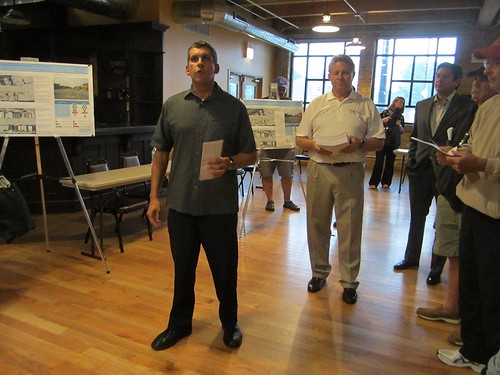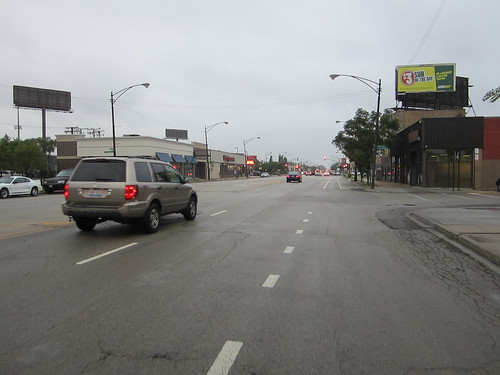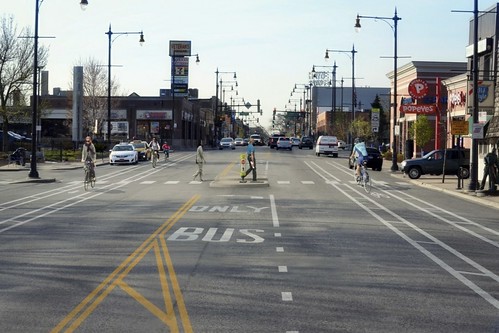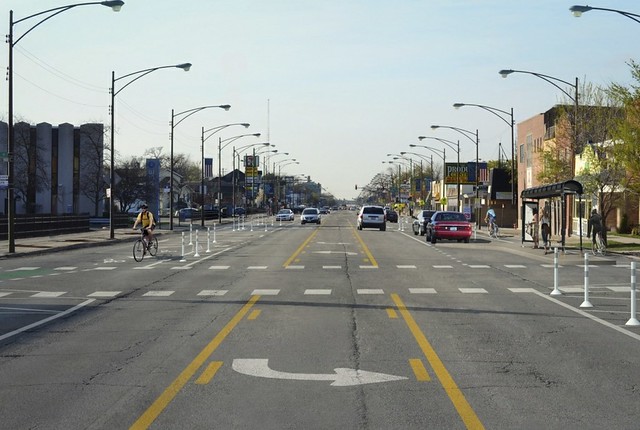Last night, announced aldermanic candidate John Garrido hijacked a crowded community meeting about the city’s proposal for a safety overhaul of Milwaukee from Lawrence to Elston. He interrupted the event to present Chicago Department of Transportation engineers with what he said were 4,000 signatures in opposition to any reconfiguration of the street that would involve fewer travel lanes.
Most of this stretch of Milwaukee is a five-lane speedway, and the project area saw 910 crashes between 2008 and 2012, causing at least 17 serious injuries and three deaths, according to CDOT. In January of this year, two men were killed in a rollover crash on the 6000 block of the street, just south of Elston.
This section consistently averages well under 20,000 vehicles, making it the least busy stretch of Milwaukee in the city. But while Milwaukee south of the Kennedy Expressway is generally a two-lane street, north of the Kennedy it has two travel lanes in each direction, plus turn lanes, and the excess capacity encourages speeding. Recent CDOT traffic studies found that 75 percent of motorists broke the 30 mph speed limit, and 14 percent exceeded 40 mph, a speed at which studies show pedestrian crashes are almost always fatal.
This stretch of Milwaukee is slated to be resurfaced next year, and CDOT plans to use the opportunity to reconfigure the street to improve safety for pedestrians, bike riders, transit users and drivers. The project would use $1.5 million in funding, eighty percent of which would come from federal Congestion Mitigation and Air Quality Improvement grants.
At the open house at the Copernicus Center in Jefferson Park, CDOT presented various scenarios for the street makeover [PDF of presentation]. Currently, Milwaukee between Lawrence and the Kennedy, including the area around the Jefferson Park Transit Center, is a two-lane street with rush-hour parking controls. CDOT has proposed eliminating the RHPCs on this stretch to make room for buffered bike lanes.
The department presented three possible configurations for the stretch of Milwaukee between the Kennedy and Elston, which has five lanes. Option A would retain all travel lanes and add a buffer on one side of the existing conventional lanes. Option B would convert one travel lane in each direction to wide bike lanes with buffers on both sides. Option C would convert travel lanes to parking-protected bike lanes, which would provide the greatest benefit in safety for all road users, since the bike lanes would also shorten crossing distances for pedestrians and discourage speeding by motorists.
All three scenarios would also add high-visibility crosswalks, pedestrian islands, and better traffic signal coordination. Studies have shown that street configurations with a total of two travel lanes plus a turn lane in each direction can easily handle up to 20,000 vehicles per day, so CDOT predicts that options B and C would have little negative impact on traffic flow and would actually improve northbound traffic flow during the morning rush.
Option C would require removing roughly 20 percent of on-street parking spaces to maintain sight lines. However, parking counts show that, in general, spaces on this stretch of Milwaukee are currently used as little as 50 percent of the time, and not more than 90 percent of the time, so there would be a relatively minor impact on the availability of parking.
Meanwhile, by making walking and biking safer and more pleasant, the project is likely to encourage more foot traffic. In other cities where travel lanes were converted to protected bike lanes, retail sales have increased after implementation. For example, in 2007, a protected bike lane and pedestrian islands were installed, and a travel lane removed, on Ninth Avenue in Manhattan’s Chelsea neighborhood. Sales increased 49 percent over three years, outpacing both neighboring retail streets and the rest of the borough.
At the hearing, CDOT officials collected input from attendees to incorporate into the final design, which will be presented at a meeting later this summer. Despite the fact that the road diet configurations would bring major safety, mobility and economic benefits, with minimal drawbacks for drivers, many attendees said they were against options B and C.
However, I counted nine bikes locked to the fence outside the center, and spoke to several people who supported travel lane conversions for safer walking conditions and protected bike lanes. “I think we need more pedestrian and bike [facilities] for people in this city,” said Tom Czaczynski, a retired carpenter who lives in neighborhood. “I’m tired of dealing with cars all the time. Even though I have two cars of my own, I like to ride my bike and I like to walk.”
Pete Czosnyka, a longtime local resident and civil engineer, was also firmly in support of Option C. “Option A sucks,” Pete said. “The mild buffered bike lanes with no road diet – that’s not going to change anything for people who are afraid of biking next to fast traffic and opening car doors. It’s not anybody’s idea of a complete street.”
Local alderman John Arena, who has hosted the meetings on the street reconfiguration, said he has not yet endorsed any of the options, but wants to see major improvements made to Milwaukee. “We know that the data shows we have a high number of crashes here, a lot of them related to the increased speeds,” he said. “That negatively affects our business climate here. We need to think of this roadway as being for more users here than just the auto-centric use that it is now.”
Garrido, a Chicago police officer and part-time lawyer who narrowly lost to Arena in the last election, has spearheaded opposition to the lane conversions. In January, after the first hearing on the CDOT proposal, Garrido launched an online petition opposing a road diet on Milwaukee, which has garnered more than 780 supporters. In response, bike advocate Bob Kastigar started his own online petition endorsing plans for lane conversions, which has over 700 signatures.
In the middle of yesterday’s open house, Garrido and Gladstone Park Chamber of Commerce president Dave Wians showed up with a large entourage, including TV news cameras. From the middle of the room, Garrido loudly announced that they had collected 4,000 signatures from residents opposed to lane conversions, which they then presented to CDOT consultant Nathan Roseberry.
Garrido told me he’s not opposed to the safety overhaul. “We’re not trying to be obstructionist,” he said. “We want this project here. We don’t want to stop it. We want to slow down traffic. We want the pedestrian islands, traffic light timing and bumpouts at the major intersections. We don’t mind the buffered lanes.” He confirmed that he’ll be running against Arena again in February’s election.
Showing up at the open house with a thick stack of petitions for the benefit of news crews was a shrewd political move by Garrido. However, by lobbying to largely maintain the status quo on a street where speeding is the norm, and crashes take place roughly every other day, the candidate is working against the safety of his would-be constituents.
Instead of blocking changes that could potentially save lives, he should take a look at streets like Kinzie, Dearborn, South Chicago and Vincennes, where similar road diets for PBLs have already reduced speeding and improved safety. In those parts of town, the aldermen showed real leadership, not just bravado.
Streetsblog Chicago will resume publication on Monday. Have a great Fourth of July!








